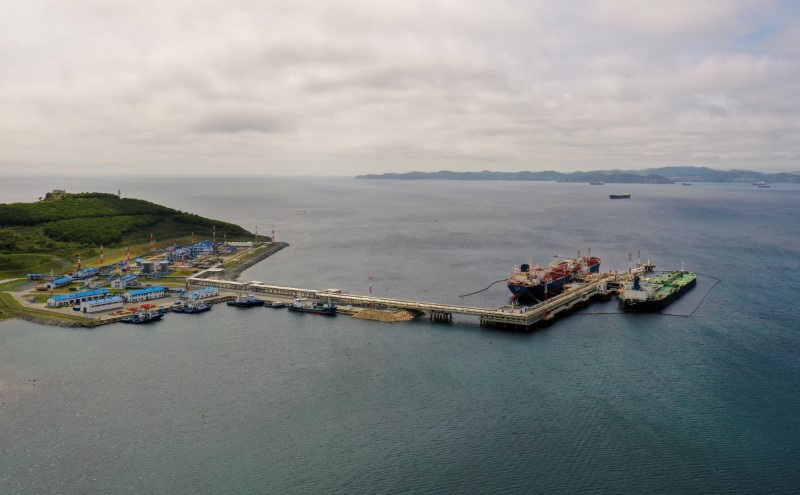Commodities
Exclusive-Western insurers provide cover for Russian oil despite price cap concerns

By Jonathan Saul and Gleb Stolyarov
LONDON (Reuters) – A group of Western insurers have provided cover for tankers carrying Russian crude, keeping its oil flowing after many in the trade sector withdrew for fear of breaching the rules of a G7 price cap, data from traders and shippers shows.
The data seen by Reuters showed that five insurers, including American Club, Luxembourg-headquartered West of England and Norway’s Gard, provided cover for 10 tankers that sailed from Russia to Asia this year.
American Club and West of England provided insurance for two vessels – the Gioiosa and the Orion I – that made similar voyages in early 2024.
Both vessels took on board crude from the state-owned Russian oil company Rosneft in Russia’s Baltic and sailed to China, the data showed.
American Club said the ship, which flew the Panama flag, was on its cover list. West did not comment on specific tankers.
Norway’s Gard, which data showed covered a separate vessel, also declined to comment on specific ships.
The three non-profit mutuals, who insure ships against oil pollution, injury and loss of life, say they are providing a service to their members.
The extent of the ongoing provision by Western insurers in covering specific Russian oil deals has not been previously reported since the cap was imposed in 2022 following the war in Ukraine.
The cap, imposed by the Group of Seven industrialised nations and their allies to curb Moscow’s ability to finance the war, only allows Western insurers and ships to participate in Russian oil trade if the oil is sold below $60 a barrel.
Many of those who stopped trading such cargoes said they were doing so because they could not be certain about the price of the oil carried by the ships they were insuring.
Russia, which has banned its firms from complying with the price cap, sold its flagship Urals crude at Baltic ports for an average of $69.4 per barrel so far this year, well above the price cap, LSEG data shows.
Insurers and ship owners are not expected to investigate the price.
Instead, Western enforcement agencies including the U.S. Treasury require insurance companies to request so-called attestations from the parties that buy and sell the crude that the oil changed hands below the price cap.
‘FLAWED’ PROCESS
The International Group (IG) of P&I Clubs – which provides insurance for 90% of the world’s fleet – said in April the attestation process was flawed and risked exposing its members to breaches of the price cap.
The IG did not respond to a request for comment on the risks for this story.
The insurers identified by Reuters said separately they rely on the attestation letters from the participants in the trade that all work was legal and complied with Western sanctions.
Reuters could not contact any of the parties as they were not named due to commercial confidentiality.
IG member American Club said it did not have direct access to price information when providing cover for the Gioiosa tanker.
Gard said it relied on price cap attestation and was also checking additional sources of data and information. Both companies referred further questions on the cap to the IG.
The other insurance providers for Russian oil included Maritime Mutual from New Zealand and IG member London P&I Club, Reuters research based on the shipping and trading data showed.
Maritime Mutual and London P&I did not respond to a request for comment on the potential risks.
However, Maritime Mutual, which is not part of the IG group, provided Reuters with a copy of its Russian oil insurance policy and a blank copy of an attestation letter which states that coverage will be withdrawn if a shipment violates the price cap.
The letter asks a company seeking cover – usually a charterer or a shipper – to tell its insurer the name of the vessel, its port and date of loading and discharge.
It asks the charterer to attest the shipment is in compliance with the price cap but does not require inclusion of the price paid anywhere in the attestation.
West also told Reuters the price cap regime treats ship owners and insurers as indirect participants of the transactions, known as tier three, hence they are not obliged to verify prices.

“The charterer/trader will never give away that (price) information and give away their margins,” Tony Paulson, West’s head of Asia and corporate director, told a Lloyd’s List podcast last month.
Gard, West P&I, American Club said they would end the cover if information emerged that the attestation was inaccurate and the price was above the cap.
Commodities
Oil prices rise; U.S. crude inventories plunge, Russia-Ukraine truce eyed
Commodities
India’s Reliance to stop buying Venezuelan oil over US tariffs, sources say
Commodities
Oil prices climb on Venezuela supply worries

 Forex3 years ago
Forex3 years agoForex Today: the dollar is gaining strength amid gloomy sentiment at the start of the Fed’s week

 Forex3 years ago
Forex3 years agoUnbiased review of Pocket Option broker

 Forex3 years ago
Forex3 years agoDollar to pound sterling exchange rate today: Pound plummeted to its lowest since 1985

 Forex3 years ago
Forex3 years agoHow is the Australian dollar doing today?

 Cryptocurrency3 years ago
Cryptocurrency3 years agoWhat happened in the crypto market – current events today

 World3 years ago
World3 years agoWhy are modern video games an art form?

 Commodities3 years ago
Commodities3 years agoCopper continues to fall in price on expectations of lower demand in China

 Economy3 years ago
Economy3 years agoCrude oil tankers double in price due to EU anti-Russian sanctions























